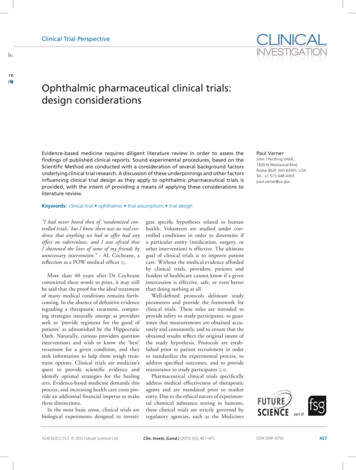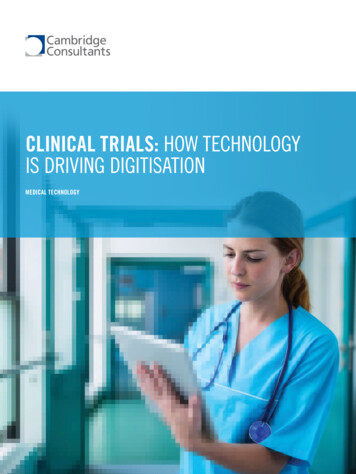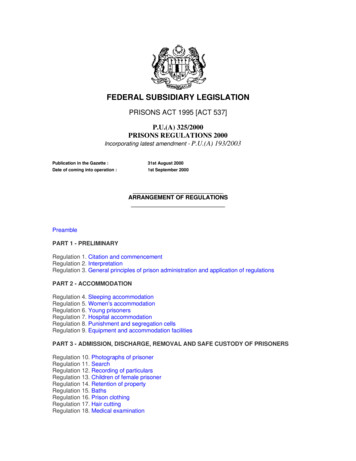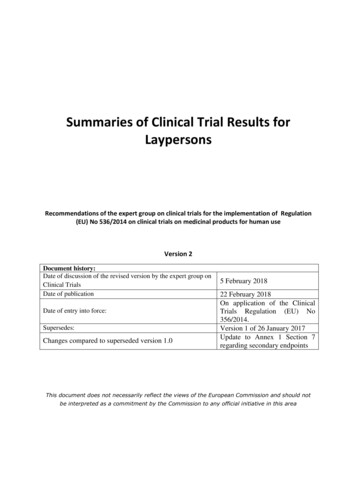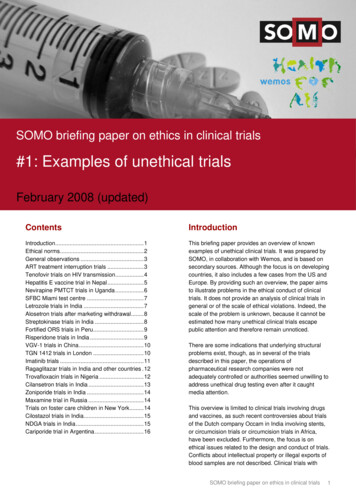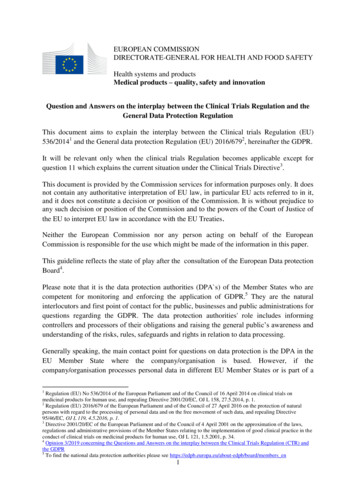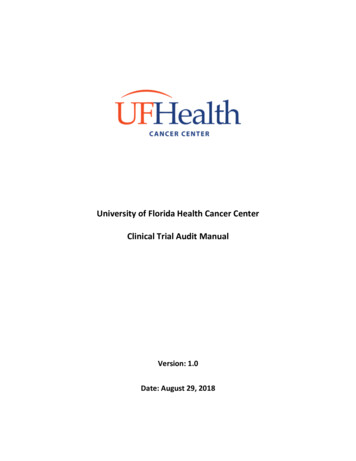
Transcription
White PaperThe EU Clinical Trials Regulation –Main Changes and Challenges
The EU Clinical Trials Regulation – Main Changes and ChallengesTable of Contents1. Introduction . 32. Main Changes and Associated Challenges . 42.1 Procedure for Initial Authorisation . 42.2 Procedure for Addition of a Member State . 72.3 Procedure for Substantial Modification . 82.4 Notifications on Patient Recruitment and Clinical Trial Events . 82.5 Safety Reporting Requirements . 92.6 Clinical Trial Data Transparency . 93. Conclusions . 104. References . 115. About The Author . 116. About CROMSOURCE . 11February 2015Page 2
The EU Clinical Trials Regulation – Main Changes and Challenges1.IntroductionCurrently all clinical trials performed in the European Union must be conducted inaccordance with the EU Clinical Trials Directive (EU-CTD)1. Issued in April 2001, the EU-CTDwas implemented by May 2004 by transposition into the national laws of the EU MemberStates. By incorporating the principles of Good Clinical Practice within EU legislation, the EUCTD imposed standards which have improved both the safety of participants in clinical trialsand the quality of the generated data. However, the EU-CTD has also been criticised by allstakeholders because of its disharmonised interpretation and application between theMember States, increased costs and administrative burdens, and delays especially forlaunching multi-national trials. Indeed, under the EU-CTD framework, a sponsor wishing toconduct a clinical trial in several Member States must submit a clinical trial application tothe Competent Authorities and Ethics Committees in each individual Member State and theauthorisation procedures are performed separately in each Member State. As well as beingtime consuming and inefficient, this has led to the possibility of regulatory approval beinggranted in one EU country but not in another.With the aim to remedy to the shortcomings and improve the attractiveness of EU forclinical research, the European Commission published on 17 July 2012 a proposal for an EUClinical Trials Regulation. This proposal went to extensive consultation and debates by theEuropean Parliament and Council of Ministers. The Clinical Trials Regulation (EU-CTR)2 wasfinally adopted on 16 April 2014 and it was published on 27 May 2014 in the Official Journal.Nevertheless, the application of the Regulation will not occur before 28 May 2016 as it isconditional on the confirmed functionality of the required IT infrastructure (EU-portal andEU-database) that will be developed by the European Medicines Agency (EMA), incollaboration with the Member States. The EU-portal will be the single entry point for thesubmission of all data and information relating to clinical trials. The EU-database willconstitute the single repository of all submitted information through the EU-portal, relatedto a clinical trial and, unless confidentiality is justified, it will be publicly accessible.When applicable, the EU-CTR will repeal the EU-CTD. As any regulation, the EU-CTR willdirectly be binding for all Member States and will therefore ensure identical rulesthroughout the EU. Currently, it is expected that the new regulatory framework set up bythe EU-CTR will apply by mid-2016.The scope of the new Regulation is identical to the existing EU-CTD in that it concerns allclinical trials conducted in EU. Several key definitions have, however, been clarified (e.g.clinical study, clinical trial, non-interventional study, substantial modification) or introduced(e.g. start of a clinical trial).On the other hand, the EU-CTR establishes new rules in particular for the authorisationprocedures, for notifications on subject recruitment and clinical trial events, for safetyFebruary 2015Page 3
The EU Clinical Trials Regulation – Main Changes and Challengesreporting requirements and for reporting of clinical trial results. This white paper will focuson these changes and highlight their associated challenges.2. Main Changes and Associated Challenges2.1Procedure for Initial AuthorisationSubmissionIn order to obtain an authorisation the sponsor/applicant will submit at the same time, viathe EU-portal, a single application dossier to all Concerned Member States (CMS) where it isintended to conduct the trial.Using a harmonised format (see Annex I of EU-CTR for details), the application dossier willconsist of two parts:oPart I contains the common scientific documents : application form, protocol,investigator brochure, Good Manufacturing Practice documentation, InvestigationalMedicinal Product Dossier (IMPD), Auxiliary Medicinal Product Dossier, IMP/Auxiliarylabels, scientific advice and Paediatric Investigation Plan (PIP) decisionoPart II contains the national documents : subject recruitment arrangements, patientinformation sheet and informed consent form, investigators and facilities suitability,subject damage compensation, financial compensation to subjects, investigators andsites, data protection requirementsIn the application dossier, the sponsor will berequired to propose one of the ConcernedMember States (CMS) as the ReportingMember State (RMS) who will coordinate thevalidation and evaluation of the application.The proposed RMS may decline or another CMSmay be willing to act as RMS. In this case, allCMS will need to find an agreement and within6 days from submission, confirmation aboutRMS shall be provided to the sponsor through the EU-Portal. The Regulation foresees thatrecommendations on criteria for the RMS selection will be prepared by a dedicated advisorygroup, the CTAG (Clinical Trials Coordination and Advisory Group). In view of RMS’responsibilities, this is particularly important to avoid that workload is concentrated on asmall number of Member States.Generally, Part I and Part II will be submitted together. However there is a possibility for asponsor to request to first submit an application limited to Part I for review, followed byPart II application up to 2 years after Part I conclusion. In these circumstances, the sponsorFebruary 2015Page 4
The EU Clinical Trials Regulation – Main Changes and Challengeswill have to certify that there is no new scientific information that could change the validityof Part I information and assessment.ValidationWithin 10 days from submission, the RMS will validate the application for completeness,taking into account comments expressed by the other CMS. Only the RMS may send arequest for additional information to the sponsor. To resolve validation deficiencies, oneclock-stop (10 days for sponsor’s response and 5 days for RMS decision) is allowed. If theRMS does not provide feedback within the defined timeframe, this will be considered as atacit validation of the application. On the other hand, sponsor’s failure to reply within thefixed deadline will lead to the automatic withdrawal of the application in all CMS.AssessmentThe new evaluation procedure distinguishes between the aspects covered by Part I or Part IIof the application dossier.oPart I – Scientific PartThe RMS will perform the review and within 45 days from validation date, it shall drawup a Part I assessment report.In the case of a multinational trial, all CMS must collaborate in the evaluation.The 45 days reporting period is then divided as follows:1) initial assessment and preparation of a draft Part I assessment report by RMSwithin 26 days2) coordinated review of the draft Part I report by all CMS within 12 days3) finalisation of the Part I assessment report by RMS and submission to sponsor andall CMS, within 7 days.Between the validation date and the reporting date (Day 45), considering issues raisedby CMS, only RMS may request additional information to the sponsor. In this case, thereporting period may be extended up to 31 days by RMS (12 days for sponsor answers,12 days for joint review of additional provided information by all CMS, 7 days forfinalisation of assessment report by RMS). Just as for the validation of the application,the lack of sponsor’s response by the fixed deadline will be considered as withdrawalof the application in all CMS.In order to consult experts, for trials involving an advanced therapy or a biotechnologymedicinal product, the RMS may extend the initial review period by 50 days.At the end of the review, the RMS shall provide in the Part I assessment report aconclusion whether the conduct of the trial is acceptable, acceptable subject tospecific conditions or not acceptable. A conclusion by the RMS that the trial is notacceptable shall be deemed to be the conclusion of all CMS.February 2015Page 5
The EU Clinical Trials Regulation – Main Changes and ChallengesoPart II – National PartThe Part II assessment will be conducted separately by each individual CMS for its owncountry. When Part I and Part II are submitted together (i.e. the most commonsituation), Part II assessment will be performed in parallel with Part I review. The sametimelines than for Part I evaluation apply. When additional information is needed, theCMS may extend the evaluation period by up to 31 days (12 days for sponsor answer,19 days for final assessment by CMS). The sponsor must provide their answer to theCMS within the deadline, otherwise automatic rejection of the trial in that country willresult.It should be noted that despite a commonformat is defined for the clinical trialapplication, the precise information whichmust be provided to satisfy Part IIrequirements is not explicitly defined.Accordingly, amount and type of data forPart II will remain governed by nationallaws.Part II covers aspects typically examined by Ethics Committees. However, as indicatedin the Regulation, the review by the ethics committee may encompass aspectscovered by Part I.It is left to each Member State to determine which appropriate body(ies) will beinvolved in the assessment of the application and to organise the involvement ofethics committees.Nevertheless, the Regulation stipulates that a Member State must provide a singledecision within 5 days of the Part I assessment reporting date or by the last day of thePart II assessment. Moreover, it specifies that Member States shall ensure that thetimelines and procedures for the review by the Ethics Committees are compatible withthe timelines and procedures set out in the Regulation. Therefore, ensuring aneffective coordination and collaboration between Competent Authorities and EthicsCommittees for the application review will constitute a major challenge, for asuccessful implementation of the EU-CTR.DecisionEach CMS will notify the sponsor through the EU-portal, of its single decision covering bothPart I and Part II, within 5 days of the Part I assessment report date or from the last day ofPart II assessment, whichever is later. If the CMS does not give its decision within thistimeframe then the conclusion of the RMS Part I assessment report will automatically beconsidered as CMS decision on the application.February 2015Page 6
The EU Clinical Trials Regulation – Main Changes and ChallengesCMS will provide a decision whether the trial is authorised, authorised subject to specificconditions or refused.A CMS may refuse to authorise a clinical trial when:a) an ethics committee has issued a negative opinion, which in accordance with the CMS’law is valid for the entire country;b) it finds, on duly justified grounds, that Part II requirements are not complied with;c) it disagrees with the conclusion of the RMS of Part I assessment report.A CMS has only three grounds to disagree with RMS conclusion of Part I assessment report:1) infringement of its national law as referred to in Article 9O (i.e. with regards to prohibitedor restricted use of specific types of human or animal cells or medicinal productscontaining or deriving from these cells or on abortifacients or narcotics)2) considerations as regards subject safety and data reliability and robustness3) considerations that participation in the clinical trial would lead to a subject receiving aninferior treatment than in normal clinical practice in the CMS.Although the CMS will need to provide a detailed justification in case of disagreement, thepossibilities to opt out leave room for national interpretation.Figure 1: Summary of initial authorisation procedure under EU-CTR2.2Procedure for Addition of a Member StateThe procedure to extend the trial to a new Member State follows the same approach as forthe initial authorisation: the same provisions for application submission, CMS applicationevaluation and CMS disagreement apply. The RMS remains the same and the CMS shallnotify its decision to sponsor within 52 days or 83 days in case of request for additionalinformation.February 2015Page 7
The EU Clinical Trials Regulation – Main Changes and Challenges2.3Procedure for Substantial ModificationAfter a trial has started, changes may need to be made by a sponsor (e.g. protocolmodifications, addition of a site ). As is the case now under the EU-CTD framework,approval prior to implementation will only be required for substantial modifications underthe new framework. The definition of substantial modification in the Regulation iscomparable to that of substantial amendment under EU-CTD. The definition covers anychange to any aspect of the clinical trial which is made after notification of a decision andwhich is likely to have a substantial impact on the safety or rights of the subjects or on thereliability and robustness of the data generated in the clinical trial.A substantial modification may concern a change to Part I, to Part II or to both parts. Theprocedure for introducing a substantial modification follows the same principles as for theinitial authorisation. The same RMS as for initial application will be involved. If themodification only concerns Part I, the RMS shall validate the application within 6 days ( 15days in case of request for additional information) and complete its assessment reportwithin 38 or 69 days, depending on whether comments have been raised and requiredanswer from sponsor. Each CMS has then 5 days to communicate decision to sponsor on thesubstantial modification.If the modification only concerns Part II, only the CMS is involved in the assessment, withsame timeframe as for a Part I modification. When the change affects both Part I and Part II,each assessment as described above will be run in parallel.2.4Notifications on Patient Recruitment and Clinical Trial EventsUnder EU-CTD framework, the only clinical trial events to be notified on an EU basis by thesponsor to Competent Authorities and Ethics of Committees are the global end of the trial, atemporary halt and early trial termination, within 90 or 15 days respectively. Some EUMember States (e.g. France or Netherlands) also ask to be informed on the start of the trialor on other clinical trial events (e.g. in France, the national end of the trial).With the objective to increase transparency surrounding patient recruitment, theRegulation sets up a harmonised but more demanding notification scheme. Under theRegulation the sponsor must notify each CMS within 15 days of the following events: start ofthe trial (i.e. first act of recruitment of a potential subject, unless otherwise defined inapproved protocol), first visit of first patient, end of recruitment, end of trial, end of trial inall EU Member States, end of trial in all third countries, temporary halt of trial, resuming thetrial after a temporary halt and early termination of trial. The sponsor will be required toperform these notifications through the EU-portal. In order to comply with all thesenotification requirements in a timely and organised fashion, it is recommended thatsponsors or their delegates implement an appropriate system.February 2015Page 8
The EU Clinical Trials Regulation – Main Changes and Challenges2.5Safety Reporting RequirementsThe Regulation establishes simplified safety reporting requirements and a streamlinedreview of safety information. At present, suspected unexpected serious adverse reactions(SUSAR’s) are submitted to and assessed separately by all Competent Authorities and EthicsCommittees of the different concerned Member States. The same is true for theDevelopment Safety Update Report (DSUR) for an investigational medicinal product, whichmust be provided on a yearly basis.Under the EU-CTR framework, the sponsor will submit all SUSAR’s as well as the DSURthrough the dedicated module of the Eudravigilance database maintained by the EuropeanMedicines Agency (EMA). The EMA will then forward the safety information electronically toall CMS, and CMS will cooperate in assessing the information reported. The Regulation alsospecifies that the responsible ethics committee shall be involved in the evaluation. Thisrequired collaboration is new in the framework of clinical trials legislation in the EU. Detailsin the form of Delegated Acts are expected from the Commission to formalise the modalityrules concerning this cooperation.2.6Clinical Trial Data TransparencyIn recent years there has been growing support for increased transparency and disclosure ofclinical trial information. The EU-CTR recognises this and establishes new rules for thereporting of clinical trial results and public disclosure. The EU-CTR requires that unlessotherwise provided in the approved protocol, within one year from the end of the trial in allCMS, the sponsor must submit a summary of clinical trial results to the EU-database. Thissummary shall be accompanied by a layperson summary. The content for the clinical trialresults summary and the layperson summary is defined in respectively Annex IV and V of theEU-CTR. However, it can be expected that the Commission will adopt delegated acts tofurther specify the requirements.Furthermore, when the trial performed was intended to support a marketing authorisationfor the medicinal product, the marketing authorisation applicant will be required to submitto the EU-database the clinical study report within 30 days following marketingauthorisation decision.These features introduced by the EU-CTR should meet general public demand fortransparency on clinical trial data.February 2015Page 9
The EU Clinical Trials Regulation – Main Changes and Challenges3. ConclusionsThe Regulation certainly represents a significant steptowards harmonisation for the conduct of clinical trials inEU. It sets up a common procedure for all types of clinicaltrial applications with a coordinated assessment by theReporting Member State for the scientific documents(Part I), with one single decision issued by eachConcerned Member State covering scientific and ethicalreview and within defined deadlines applicable for allMember States. In addition, the Regulation also provides simplified and streamlined safetyreporting requirements and establishes that Member States shall cooperate on safetyinformation assessment. However several aspects remain to be determined or evaluated atnational level and hence this leaves room for national requirements and interpretation.Furthermore, the provisions laid down in the Regulation also reflect societal demands forincreased transparency on clinical trial information.Before the implementation of the Regulation foreseen for mid-2016, a lot of work remainsto be done.This concerns, in particular:othe development of the required IT-infrastructure (EU-Portal and EU-Database) bythe EMA. The EMA has started to work with Member States and a range of stakeholders,with the intent to confirm full functionality by December 2015othe adaptation of the national legislations to fit the new EU framework, specificallyin setting an efficient collaboration model between competent authorities and ethicscommittees to ensure clinical application review. Consequently, it can be expected thatupdates of national legislations will occur in the course of 2015 to prepare the EU-CTRimplementationothe recommendations concerning the criteria for RMS selectionothe delegated acts from European Commission to provide procedural details forsafety reporting and clinical trials results summary requirements.In order to ensure a smooth transition to the new regulatory framework, sponsors shouldnot only follow closely the development of the upcoming implementing measures (seeabove for some examples) but also start to put in place relevant measures to ensurecompliance (e.g. adaptation of clinical trial application process, implementation of a suitablesystem for notifications).CROMSOURCE is aware of the need to prepare for the upcoming changes and continuouslymonitor the changes in the regulatory framework. Regulatory update trainings are regularlyFebruary 2015Page 10
The EU Clinical Trials Regulation – Main Changes and Challengesprovided for employees and the CROMSOURCE Regulatory Compliance Unit publishesRegulatory Newsletters on a quarterly basis. If you are interested, you can view thesenewsletters via the CROMSOURCE website, http://www.cromsource.com/category/news/.4. References1.EU-CTD or Directive 2001/20/EC of the European Parliament and of the Council of 4April 2001 on the approximation of the laws, regulations and administrativeprovisions of the Member States relating to the implementation of good clinicalpractice in the conduct of clinical trials on medicinal products for human use.2.EU-CTR or Regulation (EU) No 536/2014 of the European Parliament and of theCouncil of 16 April 2014 on clinical trials on medicinal products for human use, andrepealing Directive 2001/20/EC.5. About The AuthorVeronique Debaut holds a master in bioengineering from Université Catholique de Louvain(Belgium). She started her career in the pharmaceutical industry in the year 2000, where sheled regulatory affairs projects related to the marketing authorisation and life cyclemanagement of medicinal products. In 2011, she joined CROMSOURCE in Kraainem(Belgium) where she works as Regulatory Compliance Manager.Veronique may be contacted at veronique.debaut@cromsource.com.6. About CROMSOURCECROMSOURCE is a highly qualified ISO-certified international provider of outsourcedservices to the pharmaceutical, biotechnology and medical device industries, specialized inclinical development and staffing solutions.Operating through offices across all regions of Europe and North America, CROMSOURCEdelivers a comprehensive breadth of services. We seamlessly move biopharmaceuticalproducts from first in human conducted in our exceptional early phase unit through allsubsequent phase of pre- and post-approval research internationally. Our medical deviceexperts oversee projects through regulatory strategy and submission to pilot and pivotalclinical investigations in Europe and North America. Our Staffing Solutions Team ensuresthat high quality professionals are available to support your work whenever you need moreresources.February 2015Page 11
END-TO-END GUARANTEETIME, COST & QUALITY GUARANTEEDGUARANTEED FIXED PRICE BUDGETGUARANTEED ENROLMENT & TIMELINESNorth American Headquarters:European Headquarters:e-mail us at:One Alewife Center, Suite 120Via Giorgio De Sandre, 3cromsource@cromsource.comCambridge, MA 02140 - USA37135 Verona - ItalyPhone 1 617 871 1128Phone 39 045 8222811
clinical trials conducted in EU. Several key definitions have, however, been clarified (e.g. clinical study, clinical trial, non-interventional study, substantial modification) or introduced (e.g. start of a clinical trial). On the other hand, the EU-CTR establishes new rules in particular for the authorisation



